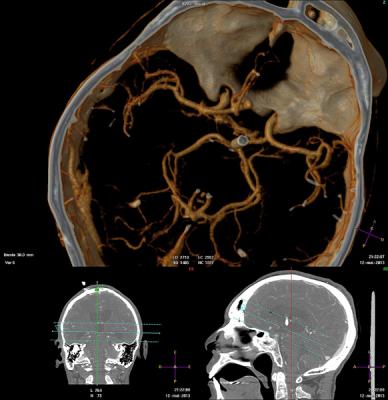
The computed tomography angiography (CTA) consists of injecting contrast into the venous circulation of the patient, followed by a series of x-ray images (lower two images). The radiologist then reconstructs three dimensionally the main arteries of the brain using the computer with special software. This is a computer generated image, it is not as sharp as a regular photograph, but it is the sharpest image that can be delivered to date. In this case this CTA shows an anterior communicating artery aneurysm. Getty Images
June 1, 2022 — The current shortage of iodinated contrast in the United States due to the COVID-19 related production shutdown in China is causing severe disruptions in patient care. A new Harvey L. Neiman Health Policy Institute study outlines the most frequently used computed tomography (CT) services performed on Medicare beneficiaries as focus areas for mitigation strategies for the greatest overall impact.
The Journal of American College of Radiology (JACR) study looked at 9.6 million CTs involving iodinated contrast in the Medicare Physician/Supplier Procedure Summary file which represents 100% of Medicare Part B claims in 2019 – the latest pre-pandemic year of data available. The study found that utilization of contrast enhanced CT was highest in the outpatient hospital and emergency department settings. By body region, utilization was highest for the abdomen/pelvis, particularly in outpatient hospitals and emergency departments, followed next by chest CT. For CT angiography, the highest relative utilization relative to standard CT was of the brain followed by head/neck, and in the emergency department and hospital inpatient settings.
According to lead author, Richard Duszak, Jr., MD, Professor and Vice Chair for Health Policy and Practice in the Department of Radiology and Imaging Sciences at Emory University School of Medicine and Neiman HPI Affiliate Senior Research Fellow, “the highlighted site of service and body region differences may help guide the creation of the most impactful teams via multi-disciplinary collaboration to balance mitigation with clinical service needs.”
Computed tomography (CT) with contrast is increasingly relied upon for the diagnosis and follow up of a variety of conditions. “The results of this study can help guide current intense efforts nationally and institutionally to identify strategies to minimize or avoid iodinated contrast use by using alternative imaging modalities, contrast agents, or protocols that reduce or minimize waste resulting from individual doses,” says Dr. Duszak. “Such strategies will be most efficient and impactful when focused on the most frequently used services.”
For more information: https://www.neimanhpi.org/
Related Content of MRI Gadolinium Concerns
New Report Provides Strategies for Managing Contrast Shortage
AJR Publishes Best Practices for Iodinated Contrast Media Shortage
Voluntary Dismissal of Chuck Norris Gadolinium Case Involving Bracco
VIDEO: How Serious is MRI Gadolinium Retention in the Brain and Body? An interview with Max Wintermark, M.D.
VIDEO “Big Concerns Remain for MRI Gadolinium Contrast Safety at RSNA 2017,” An interview with Emanuel Kanal, M.D.
Radiology Has Failed to Properly Assess or Track MRI Gadolinium Contrast Safety
Recent Developments in Contrast Media
FDA Committee Votes to Expand Warning Labels on Gadolinium-Based Contrast Agents
European Medicines Agency Issues Update on Gadolinium Contrast Agents


 December 05, 2025
December 05, 2025 









